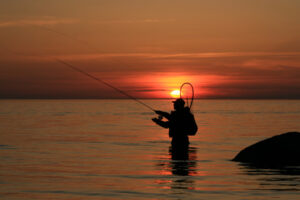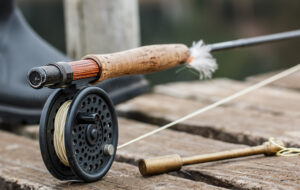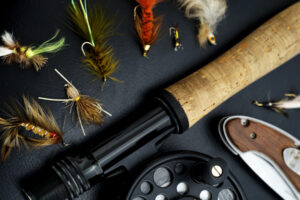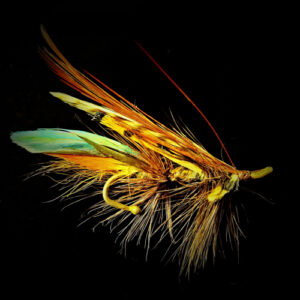Fly Fishing How To. How to get started and what fly fishing gear will you need?

Fly fishing is an amazing fishing discipline and an art. However, it sometimes can be a bit frustrating with all the equipment, names and knowing where to start.
So we are going to look at some information on fly fishing how to. In this case, how to get started and what fly fishing gear you will need.
The fly fishing rod.
A fly rod differs from a normal fishing rod in that it is normally very long, thin and flexible, designed to cast a fly line.
A fly fishing rod might be nine foot in length, to ten foot or more.
Fly rods can be one piece design or two pieces.
Takedown fly rods normally of can be three of four sections. This helps when travelling to that far away fishing hotspot.
The early fly rods were made of bamboo, then fiberglass fly fishing rods were developed. Today graphite and a mixture of high tech materials are popular.
A fly fishing rod will be rated a weight. Such as a 5 weight, 7 weight, etc. The higher number, the heavier weight rod.
What size fly rod do I need?
Generally a lower weight will be used for smaller fish. A heavier weight rod for bigger fish.
As an example you might use a 5 weight fly rod for small streams and smaller fish, a 7 weight for big lakes and bigger size trout and an 8 weight for saltwater fishing for salmon.
The fly rod weight for bigger saltwater fish might be a 10 weight or more.
That being said though, a fly rod weight will depend on your preference, size fish, conditions and location, etc.
While a 5 weight is a popular size, for windy areas and bigger lakes, a heavier weight fly rod might be needed.
The fly rod’s weight will be designed to cast best with the matching fly line. As an example a 6 weight rod will perform best with a 6 weight fly line.
Sometimes a slightly lighter, or heavier fly rod will work better with a fly line weight. Depending on the rod design and construction. Such as a 6 weight fly rod performing well with a 7 weight line. But generally the same size fly rod and fly line weight, will suit the best.
A stiffer fly rod can cast into the wind better and a bigger fly. However for landing a small ant pattern on the water in front of a shy trout, a smaller weight fly rod and will work delicately together.
Most anglers will base the weight of the rod and fly line on what fish they want to target.

Fly reel.
A fly fishing reel is pretty simple compared to today’s general fishing reels, like a spinning reel, or bait caster.
A lot of time the angler won’t play a small fish on the reel, but use the fly line that is already out to pull in the fish and fight the fish.
Some fly reels will have an adjustable drag, to slow down the fly line coming off the reel.
Other fly reels are designed to use you hand to slow down the line if the fish runs. (Or should I say, swims fast.)
The fly reel should be big enough to hold the fly line and backing on it.
Normally the fly reel model will say what weight fly line it can hold. Such as the 5/6 reel can store a 5 weight fly line.
For saltwater fly fishing the reels are larger for the bigger weight fly line. They also have more room to put extra backing material for the bigger fish.
Fly lines.
The fly line is thicker than normal fishing line. It is coated and helps the fly fisherman cast the fly.
A normal fishing rod uses the weight of the sinker, float, or lure to help cast it out. But with a fly rod, the fly line does the work.
Fly lines can be tapered, such as weight forward, or double taper to give them different casting properties.
The fly line should match the rod. As an example if you have a 6 weight fly rod, you would use a 6 weight fly line.
As well as the tapered designs, fly lines also come in a variety of floating or sinking lines.
Such as some will float, some lines are designed for the tip to sink slowly. Other fly lines can sink very fast and are designed to fish in deep waters.
A fly line is only around 90 feet (27m) give or take a bit, depending on the manufacturer.
What are the best fly lines to buy?
Some good brands are Airflo, Scientific Angler and Rio Fly lines.
The fly line should be well looked after like the rod, as it is what connects the fisherman to the fish. If it is nice and clean, it will cast easier than a dirty line.
A fly fisherman might have a floating line set up on his rod, and have an extra spool. The spare spool might hold a sinking tip, or sinking line to fish deeper waters, depending on where the fish are feeding.
Fly line backing.
Because of the short length of a fly line, backing will be needed in case the fish makes a strong run with the line. The fly line would be striped easily off the reel and you would lose the fish and line.
So fly line backing is used on the reel to connect the fly line too.
Leader and tippet material.
Because the fly line is thick, you couldn’t tie the fly directly on the fly line. Also this would scare the fish if the big fly line landed next to them. So a leader is attached to the fly line.
The leader is normally tapered from a thick diameter and tapers down to thinner diameter. The thinner end then will connect to a piece of fishing line called a tippet.
The length of the leader length can range from around 6 feet (Around 182 cm.) to 12 feet (About 365 cm,) in length.
Old leaders used to be tied from several sections of different poundage lines. This formula of length and different poundage lines was kept in high regard.
The fly is tied to the tippet.
The combination of fly line, leader and tippet help cast the fly out and turnover the fly landing on the water to present it to a fish.
Extra fishing line in different poundage / strengths are normally carried for tippet material.
As an example for night fishing for big trout and where there are lots of snags, eight pound line might be tied on. For fishing in a small stream, a tippet strength of four pound line might be used.
Artificial flies.

Artificial flies are designed to imitate bait.
Some will imitate beetles, grasshoppers, or spiders falling on the water surface. Other patterns are designed to copy nymphs slowly swimming, or crawling along the bottom.
The majority of insects, both aquatic and terrestrial have been copied in one way or another as an artificial fly for fishing.
Frogs, crawfish / crawdads and leech patterns can also be imitated and tied. There are even flies that are designed to imitate mice.
Flies can be tied out of natural materials, like feather or deer hair. Others are made with synthetic material like imitation seal fur, foam and rubber to give it different properties when being retrieved or floating.
Some flies are used can be fished on top of the water surface level, which are called dry flies. Or dries for short.
The flies that are fished under the water surface are called wet flies.
There are a wide range of wet flies and they can be broken up into other categories such as nymphs. The bigger wet flies might be called streamers, which can imitate big baitfish for salmon fishing.
Other patterns that imitate baitfish might be called smelt patterns.
There are a huge variety of assorted patterns of flies and are called all names. Some of these names sound fancy, others are weird and wonderful like: Woolly bugger, Red tag, Clouser minnow, Micky Finn and Royal Wulff to name a few.
There are literally thousands of fly patterns and designs.
As well as the wide range of flies, they can be fished in lots of ways and have different characteristics on, or in the water.
Some flies are tied to sink fast, like with weighted lead, others are designed to sit just under the water surface.
Tying flies can be as addictive as, the fly fishing itself.

The fly box.
A fly box will hold your collection of artificial flies so you can easily pick and choose what fly to tie on.
Also the box ideally stops the hooks from getting tangled up or squashed.
Fly boxes can hold the hooks in all manner of ways, like foam, metal and plastic clips, some are just small compartments, yet others use magnets to hold the flies.
Some are clear plastic, others are made with an aluminum construction.
Most anglers will have one box or more for each type of fly. For example a box for dry flies, another for nymphs, a box for midges, etc.
Fly fishing vest.
With all this gear, we need some where to put all the flies and containers.
Fly fishing vest will have lots of pockets, both inside and out to carry all the gear.
Most vests are cut short so when you are in the water wading, they don’t hang low and get wet.
Starting out, you might just use a haversack style bag, or daypack. But the fly vest does make it easy to access fishing gear easily on the water.
Fly fishing waders.
Generally the fly fisherman will try to get within casting distance of the fish. So this means fishing waders to get them in the water and get close to the fish.
Waders come in a few types or length styles. Such as thigh / hip waders, waist waders and chest waders.
Some waders come in soft soled waders were you wear wading boots over them. These are called stocking foot waders.
Other types of fishing waders have boots built in the waders. Called bare foot waders.
Click on for more information – Types of Fishing Waders
What are the best waders to buy?
Some popular fishing brand waders are: Frogg Togg waders, Wilson, Orvis waders, Redington and Simms Waders.
Fishing waders might be constructed of Neoprene or PVC type materials. Most materials will have their drawbacks and advantages. Such as too hot, too cold or not breathable.
Fishing nippers.
Nippers help cut the fishing line, or tippet material close to the knot. Scissors are handy, but the nippers cut nice and flush.
The fly fishing nippers might be on a lanyard or retractable lanyard for easy access.
Fishing landing net.
Not all fly fisherman carry a landing net, but it makes life easier landing the fish.
Extendable long handles, or a short wooden traditional design, there are plenty of choices.
Polaroid sunglasses.
Polaroid sunglasses, or Polaroids as they are called, can help see in the water a bit more, by reducing the glare.
As well as helping spot some fish in clear water, they can protect your eyes from the harsh wind.
When casting flies on windy days, or for beginners these fishing sunnies also offer some protection from a stray hook.
Wide brimmed hat.
A wide brimmed hat will not only protect your from the sun, it can also help shade the face. Used with a pair of Polaroid sunglasses can help you see in the water a bit better.
A hat also protects you from the fly hook on windy days.
Extra fly fishing gear you might need.
Additional items like fly floatant, which helps a dry fly float high on the water surface. Strike indicators and split shot to put on the line are some extra items you might carry.
A headlamp for low light conditions. A dry bag for you mobile phone, in case you go for an unexpected swim. First aid kit, water bottle and a trusty knife might also be included.
A multi tool, like a Leatherman might also be carried.
Remember to pack a jacket or coat, for bad weather and tell someone where you are going. Keep safe.
Fly fishing equipment, how to get started

You don’t have to get the entire fly fishing gear at once.
A fly fishing club or fishing club might be in your area. Some will have lessons for beginners on how to fly fish. Some clubs might lend, or hire out some fly fishing gear.
Or a club member might help you out and show you the ropes.
Some fly fishing shops near you might hire out fishing gear. Also some of the package fly fishing rod and reel combos, might be worth looking at.
For learning fly casting, visit, How To Fly Fish.
What are the best fly fishing rods to buy?
Some popular brands are Orvis, Sage Fly Rods, Fenwick, Hardy, Winston, Scott and Loomis Fly Rods, to name a few.
A second-hand rod might be worth looking at, as some top of the line brands can be expensive. However the prices can vary, depending on brand, or model of fly rod.
Fishing club members might have used fly gear to sell.
You might just practice from the bank and don’t have to buy fishing waders straight away. Some rubber boots, or Muck boots might work for a start on the water’s edge.
A day pack instead of a fly vest might work, until you decide if fly fishing is for you.
Garage sales, Craig’s list and other places are worth looking at to buy some cheap fishing tackle, or a secondhand fly rod or reel.
Amazon and eBay are worth checking out for fly fishing sales and daily deals.
For beginners, for more information – Best Fly Rod And Reel For Beginners
Conclusion – Fly fishing how to. How to get started and what fly fishing gear will you need?
Fly fishing is truly addictive.
You can fish small ponds for pan fish, fly fish in remote places for trophy trout, try your hand at saltwater fly fishing targeting tuna.
With fly fishing sometimes catching an actual fish is a bonus.
Enjoy the outdoors and sights, or just fly fish with a friend and enjoy the company.
Extra Fly Fishing Resources:
How Do I Clean A Fly Fishing Line?
What Is A Tippet In Fly Fishing?
